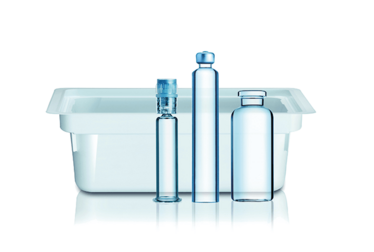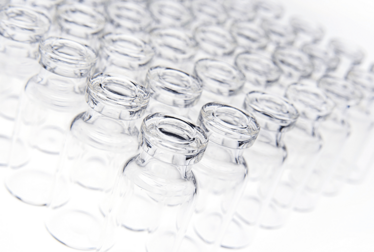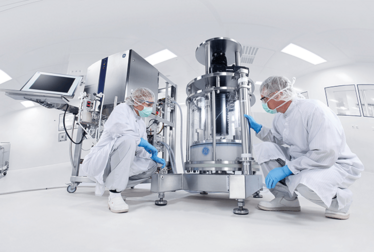The Innovators 2017
Whether better ensuring patient safety, improving process efficiency, or just making life in the lab or facility easier – meet the companies advancing pharmaceutical development and manufacture.
iQ™. The Global RTU Standard
A holistic concept standardizing ready-to-use containers within a single tub format to run on the same filling line.

With its new iQ™ platform, SCHOTT standardizes ready-to-use (RTU) syringes, vials and cartridges within one tub format to run on the same filling line.
Thus, less changing of machine parts is necessary when switching from one container to another. This allows pharma manufacturers to fill various drug/container configurations on the same filling line with only a few minutes of changeover in between. Considering that drugs today need to be manufactured in ever-smaller batches in shorter periods while adhering to higher quality standards, the iQ™ standardized tub format increases flexibility and greatly reduces complexity for pharma manufacturers.
A case study has shown that iQ™ decreases the need for format parts among others, which enables companies to reduce investments by up to 40 percent, clean room space by up to 60 percent and running costs by up to 40 percent. The platform from SCHOTT is compatible with over 30 machine platforms of all leading and also upcoming machine vendors. Close cooperation with the world’s largest elastomer component suppliers enabled the offering of pre-validated and flexible container/elastomer systems. This further reduces testing efforts, improves quality and accelerates time to market.
Moreover, the nested configurations of iQ™ containers eliminate glass-to-glass contact during filling, transport and storage. Thus, the risk of scratches and contamination is decreased significantly, which ensures and improves patient safety. Therefore, the platform also provides a solution to various industry discussions, such as glass breakage and particle reduction.
Learn more at www.schott.com/iQ
A time for Valor
Corning’s innovative glass solution for injectable drug packaging draws on generations of problem-solving with science

A revolution is forming in the way cutting-edge medicines are manufactured and delivered to patients. At the heart of it all – a new-age version of one of the world’s oldest materials.
Corning Incorporated – the New York State-based technology company – this year introduced Corning Valor™ Glass, damage-resistant and chemically durable pharmaceutical packaging for today’s medicines.
The innovation will create opportunities for pharmaceutical companies to manufacture their products more efficiently and to more safely deliver their products to patients.
Corning began developing what would become Valor Glass after a 2011 advisory issued by the U.S. Food and Drug Administration. The FDA noted at the time that several drug products had been recalled due to a formation of glass lamellae in certain injectable drugs. The formation of these glass flakes is called delamination.
The delamination process can lead to fine glass particle contamination in the drug. A longtime customer and leading pharmaceutical company looked to Corning for a damage- and delamination-resistant glass.
Corning was up to the challenge, bringing more than a century and a half of glass science and manufacturing leadership to the table.
Long history of innovation
Since its earliest days in the mid-1800s, Corning attracted researchers with a passion for glass science, optical physics, and manufacturing engineering.
They discovered that the ancient material – mostly familiar to the world in ordinary soda-lime compositions - could be endlessly changed, enhanced, and transformed to create new properties.
From its lab in upstate New York, Corning began partnering with the great innovators of the day.
In the 1880s, Thomas Edison turned to Corning to develop a clear, heat-tolerant encasement for his electric filament. Later, Corning created a process for mass-producing those bulbs quickly and cheaply, bringing electric lights to the masses.
Durable cookware and labware, along with mass-produced television tubes, were among Corning’s innovations in the early 20th century.
And in the post-World War II era – as the company consistently invested more than 10% of its revenues into research and development - Corning continued its discoveries that changed everyday life and transformed industries.
- Telephone systems in the late 1960s were built on copper wire that couldn’t reliably handle growing traffic. Corning invented low-loss optical fiber, unleashing a communications revolution.
- When the US government introduced the Clean Air Act in 1970, Corning developed an innovative honeycomb structure for trapping emissions. It has helped automakers meet stringent new regulations for decades.
- Corning’s precision glass for advanced displays has helped bring flat-screen TVs and monitors to homes and offices everywhere.
- And the consumer electronics innovation that has defined the past decade – smart mobile devices with brilliant touchscreens – has been made practical by Corning® Gorilla® Glass. The tough, beautiful cover glass is on more than 5 billion devices worldwide.
A remarkable innovation
Corning glass scientists have a deep understanding of how different formulation and fabrication techniques combine to determine the atomic state and structure of a glass, which in turn control the glass’ mechanical, thermal, and optical properties.
The company is well known for its quality-by-design approach – combining material and process knowledge to create groundbreaking technologies. Corning Valor™ Glass is a perfect case study for the company’s approach to innovation. The inventors designed a glass for pharmaceutical packaging and leveraged the company’s existing manufacturing and engineering platforms to develop and manufacture it.
Valor Glass has its own unique composition optimized to address longstanding quality issues with conventional pharmaceutical packaging. Through a root-cause analysis, Corning scientists were able to eliminate the root cause of delamination (1). In addition, the glass was designed to prevent the formation of stable through cracks and dramatically reduce the probability of glass particulate formation (2)(3). Valor Glass containers provide a safety benefit for patients using sterile injectable drugs by lowering the potential risk of contamination or loss of sterility due to cracks and particles.
In addition to helping protect patients, Valor Glass improves operational efficiency for manufacturers. Valor Glass was designed to be compatible with existing filling lines as a drop-in solution for manufacturers, requiring no capital investments to modify equipment or lines in order to adopt.
Glass on filling lines is a rate limiting factor in terms of speed and throughput. Valor Glass improves the operational efficiency of filling lines, as it enables smoother overall operations. For manufacturers this means fewer line interventions and glass-related rejects, which improves the effective throughput of the line.
Ron Verkleeren, vice president and general manager of Corning Pharmaceutical Technologies, says Corning sees Valor Glass as a large opportunity for the company.
“We are thrilled to be working with development partners and customers on the adoption of Valor Glass to store and protect medicines. The manufacture of sterile injectable drugs is not an easy thing to do, it has its challenges, but the glass package intended to protect medicines should not contribute to those challenges.”
“We want the glass to enable pharmaceutical companies to efficiently manufacture and deliver quality drug products to patients.”
Reimagine capacity for success – MabSelect™ PrismA protein A chromatography resin

As most of today’s upstream processes are of high feed concentrations, mass throughput rather than volumetric throughput is the main target for downstream process improvements. Protein A capture is the initial downstream purification step of most mAb processes. As such, the protein A capture step is subjected to large quantities of crude sample feed. To prevent protein A capture from becoming rate-limiting for the manufacturing process, high efficiency of this step is crucial. To improve performance of protein A capture, GE Healthcare has worked on optimizing both the ligand and the base matrix to develop a next-generation protein A resin that exhibits increased productivity over current protein A resins.
Co-optimization of the ligand and the base matrix is necessary, as large pores reduce steric hindrances but at the expense of available surface area, and long ligands increase the number of binding sites but can increase steric hindrances. To improve cleaning efficiency, weak points in the protein A ligand were identified and subjected to mutations to enhance alkaline stability. More than 400 different constructs were evaluated using high-throughput screening methodologies. A library of ligands was generated using a design of experiments approach, and Biacore™ surface plasmon resonance technology enabled quick evaluation of the different modifications introduced to the protein A ligand upon decision of final resin design.
Addressing higher demands for maximized productivity
The final product, MabSelect PrismA, is built on the heritage of former MabSelect products. However, with the enhanced properties of both the agarose base matrix and the protein A ligand, MabSelect PrismA offers significantly increased capacity compared with its predecessor resins. The improved capacity allows for handling of the increasing upstream titers to resolve bottlenecks in downstream mAb processing. The high capacity of MabSelect PrismA enables an increased mass throughput per purification cycle, improving productivity of current chromatography columns and systems without costly capital expenditures. MabSelect PrismA allows for up to 30 percent more product to be purified using current equipment. Alternatively, the increased binding capacity can be used to decrease the resin volume required to achieve a given mass throughput.
Optimizing cleaning and sanitization for improved process efficiency
Efficient cleaning prevents impurities from building up on the chromatography column and reducing the capacity of the resin. Efficient cleaning and sanitization protocols also help prevent growth of microorganisms and inactivate potential endotoxins. A high alkaline stability of the resin enables the use of high concentrations of low-cost sodium hydroxide as a cleaning agent, supporting both cleaning efficiency and good process economy. MabSelect PrismA exhibits more than 90 percent retained dynamic binding capacity after cleaning with 1.0 M NaOH or more than 95 percent retained dynamic binding capacity after cleaning with 0.5 M NaOH between runs for 150 cycles. The significantly enhanced alkaline stability of MabSelect PrismA ensures a better process economy, while meeting the requirements of a stringent bioburden control.
Learn more here
- Schaut, Robert A. et al. “Historical Review of Glasses Used for Parenteral Packaging.” PDA Journal of Pharmaceutical Science and Technology. July/August 2017.
- Schaut, Robert A. et al. “Enhancing patient safety through the use of a pharmaceutical glass designed to prevent cracked containers.” PDA Journal of Pharmaceutical Science and Technology. 19 September 2017.
- Timmons, Christopher et al. “Particulate Generation Mechanisms during Bulk Filling and Mitigation via New Glass Vial.” PDA Journal of Pharmaceutical Science and Technology. 15 May 2017.



















